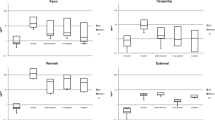Summary
The exposure to dust and polynuclear aromatic hydrocarbons (PAH) of 15 truck drivers from Geneva, Switzerland, was measured. The drivers were divided between “long-distance” drivers and “local” drivers and between smokers and nonsmokers and were compared with a control group of 6 office workers who were also divided into smokers and nonsmokers. Dust was measured on 1 workday both by a direct-reading instrument and by sampling. The local drivers showed higher exposure to dust (0.3 mg/m3) and PAH than the long-distance drivers (0.1 mg/m3), who showed no difference with the control group. This observation may be due to the fact that the local drivers spend more time in more polluted areas, such as streets with heavy traffic and construction sites, than do the long-distance drivers. Smoking does not influence exposure to dust and PAH of professional truck drivers, as measured in this study, probably because the ventilation rate of the truck cabins is relatively high even during cold days (11–15 r/h). The distribution of dust concentrations was shown in some cases to be quite different from the expected log-normal distribution. The contribution of diesel exhaust to these exposures could not be estimated since no specific tracer was used. However, the relatively low level of dust exposure does not support the hypothesis that present day levels of diesel exhaust particulates play a significant role in the excess occurrence of lung cancer observed in professional truck drivers.
Similar content being viewed by others
References
Bofetta P, Harris RE, Wynder EL (1990) Case-control study on occupational exposure to diesel exhaust and lung cancer risk. Am J Ind Med 17:577–591
Cadle S, Groblicki P, Stroup D (1980) Automated carbon analyzer for particulate samples. Anal Chem 52:2201–2206
Deutsche Forschungsgemeinschaft (1990) Gesundheitsschädliche Arbeitsstoffe toxikologischarbeitsmedizinische Begründung von MAK-Werten. VCH, Weinheim
Elbers G, Zang T, Buck M (1990) Russ-Immissionsmessungen im Einflussbereich des Kraftfahrzeugverkehrs. Staub Reinhalt Luft 50:439–443
Enjalbert P, Hure P, Goasguen JP (1988) Moteurs diesel et pollution atmosphérique en espace confine. Cah Notes Doc 133:649–665
Fabries JF, Carton B (1981) Appareils de prélèvement et de mesures de concentration de polluants particulaires utilisables en hygiene du travail. INRS, Nancy, pp 14–17
Federal Register (1989) Sept 18 54 No 179 38438
Glenn RE, Craft BF (1986) Air sampling for particulates. In: Merchant JA (ed) Occupational respiratory diseases. USBHHS-NIOSH, Cincinnati, pp 62–82
Graedel TE (1988) Ambient levels of anthropogenic emissions and their atmospheric transformation products. In: Watson AY, Bates RR, Kennedy D (eds) Air pollution, the automobile and public health. HEI Nat Med Press, Cambridge, Mass, pp 133–160
Grimmer G, Naujack KW, Schneider D (1981) Comparison of the profiles of polycyclic aromatic hydrocarbons in different areas of a city by glass-capillary-gas chromatography in the nanogram-range. Int J Environ Anal Chem 10:265–276
Gubéran E, Usel M, Bolay J, Puissant J, Raymond L (1991) Increased risk for lung cancer and for cancer of the gastrointestinal tract among Geneva professional drivers. (Submitted for publication)
Hayes RB, Thomas T, Silverman DT, Vineis P, Blot WJ, Mason TJ, Pickle LW, Correa P, et al (1989) Lung cancer in motor exhaust-related occupations. Am J Ind Med 16:685–695
Horvath H, Kreiner I, Norek C, Preining O (1988) Diesel emissions in Vienna. Atmos Environ 22:1255–1269
Huynh CK, Vu Due T, Schwab C, Rollier H (1984) In-stack dilution technique for the sampling of polycyclic organic compounds. Application to effluents of a domestic waste incineration plant. Atmos Environ 18:255–259
Huynh CK, Graf M, Vu Due T (1987) Développement d'une pompe de prelevement personnel. Arch Mal Prof 48:637–638
Kiel M (1989) The dangers of diesel. Safety & Health, September, pp 66–68
Kirkland JJ, Liebald W, Unger KK (1990) Characterization of diesel soot by sedimentation field flow fractionation. J Chromatogr Sci 28:374–378
Lehmann E, Rentel KH, Allescher W, Hohmann R (1990) Messung von Dieselabgas am Arbeitsplatz. Zentralbl Arbeitsmed 40:2–11
MacDowal D, McCleary R, Meidinger EM, Hay RH (1980) Interrupted time series analysis. Sage Public Series / Number 07-02, London
Metz N (1989) Diesel particulate emission in Germany (West). Exp Pathol 37:15–22
NIOSH (1988) Carcinogenic effects of exposure to diesel exhaust. Current Intelligence Bulletin 50:30
Pott F, Heinrich U (1987) Dieselmotorabgas und Lungenkrebs —Tierexperimentelle Daten und ihre Bewertung im Hinblick auf die Gefährdung des Menschen. In: Albers SW (ed) Umwelthygiene-Jahresbericht 1986/87, vol 19. Gesellschaft zur Förderung der Lufthygiene und Silikoseforschung Düsseldorf, pp 130–166
Pott F, Heinrich U (1988) Neue Erkenntnisse über die krebserzeugende Wirkung von Dieselmotorabgas. Z Gesamte Hyg 34:686–689
Schenker MB, Smith T, Munoz A, Woskie S, Speizer FE (1984) Diesel exposure and mortality among railway workers: results of a pilot study. Br J Ind Med 41:320–327
Statistical Graphic System (1986) Statistical Graphic Corporation Version 2.0 STSC Inc.
Steenland K (1986) Lung cancer and diesel exhaust: a review. Am J Ind Med 10:177–189
Steenland NK, Silverman DT, Hornung RW (1990) Case-control study of lung cancer and truck driving in the Teamsters Union. Am J Public Health 80:670–674
Watson AY, Bates RR, Kennedy D (1988) Air pollution, the automobile, and public health. The Health Effects Institute, Cambridge, Mass., p 692
World Health Organization (1987) Air quality guidelines for Europe. WHO Regional Publications, European Series no 23, pp 105–117
World Health Organization (1988) Diesel and gasoline engine exhausts and some nitroarenes. IARC monographs on the evaluation of carcinogenic risks to humans. 46:458
Zaebst DD, Clapp DE, Blade LM, Morris JA, Hornung RW (1990) Occupational exposures to elemental and organic carbon content of diesel exhaust emission in the trucking industry. American Industrial Hygiene Conference, Orlando, May
Ziskind RA, Carlin TJ, Ballas J (1978) Evaluating toxic gas hazards inside heavy duty diesel truck cabs. Proc Am Chem Soc 107:377–383
Author information
Authors and Affiliations
Rights and permissions
About this article
Cite this article
Guillemin, M.P., Herrera, H., Huynh, C.K. et al. Occupational exposure of truck drivers to dust and polynuclear aromatic hydrocarbons: a pilot study in Geneva, Switzerland. Int. Arch Occup Environ Heath 63, 439–447 (1992). https://doi.org/10.1007/BF00572109
Received:
Accepted:
Issue Date:
DOI: https://doi.org/10.1007/BF00572109




